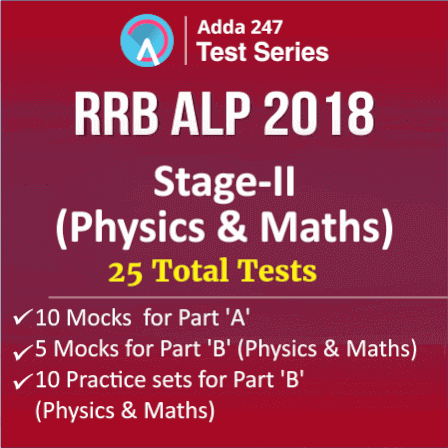Dear aspirants,
- https://www.sscadda.com/2018/12/alp-stage-2-exam-physics-notes-magnetic-part.html
Looking forward to providing you the best apt study content for every government exam at no cost thus making access to the exam content convenient for you, SSCADDA is available once again to assist you thoroughly in Railway ALP Stage 2 Exam 2018 where the motive is to enable you with Physics detailed notes on definitions, concepts, laws, formulae, rules and properties, important from the exam point of view. Stay in tune with SSCADDA to utilize the remaining time for Railway ALP Stage 2 and maximize your practice skills.
FORCE ON A CURRENT-CARRYING CONDUCTOR IN A MAGNETIC FIELD
- The magnet exerts an equal and opposite force on the current-carrying conductor.
- The direction of force is reversed when the direction of current through the conductor is reversed.
- The direction of the force on the conductor depends upon the direction of current and the direction of the magnetic field.
Rule to find the direction of the force on the conductor: Fleming’s Left-Hand Rule
According to this rule, stretch the thumb, forefinger and middle finger of your left hand such that they are mutually perpendicular. If the first finger points in the direction of magnetic field and the second finger in the direction of current, then the thumb will point in the direction of motion or the force acting on the conductor.
Devices that use current-carrying conductors and magnetic fields include electric motor, electric generator, loudspeakers, microphones and measuring instruments.
ELECTRIC MOTOR
An electric motor is a rotating device that converts electrical energy to mechanical energy. Electric motor is used as an important component in electric fans, refrigerators, mixers, washing machines, computers, MP3 players etc.
Principle: When rectangular coil is placed in a magnetic field and current is passed through it, the coil experience a torque, which rotates it continuously.
Parts of an Electric Motor
- Insulated Copper wire: A rectangular coil of wire ABCD
- Magnet Poles: A magnet as placed above ie North Pole and South Pole. This creates a magnetic field as shown above.
- Split Rings: Two disjoint C-shaped rings P and Q. It acts as a commutator (which can reverse the direction of current)
- Axle: The split rings are placed on the axle which can rotate freely.
- Brushes: The outside of the split rings are connected to conducting brushes X and Y.
- Source Battery: To source current.
- Commutator: A device that reverses the direction of flow of current through a circuit.
- Armature: The soft iron core, on which the coil is wound, plus the coils, is called an armature. This enhances the power of the motor.
ELECTROMAGNETIC INDUCTION
Phenomenon of inducing an electric current in a coil by changing the magnetic field around it.
Rule to know the direction of the induced current: Fleming’s right-hand rule
If the forefinger indicates the direction of the magnetic field and the thumb shows the direction of motion of conductor, then the middle finger will show the direction of induced current.
ELECTRIC GENERATOR
In an electric generator, mechanical energy is used to rotate a conductor in a magnetic field to produce electricity. It works on the principle of electromagnetic induction.
AC Generator
- A current, which changes direction after equal intervals of time, is called an alternating current (abbreviated as AC). The device generating AC current is called an AC generator.
- The alternating current reverses its direction periodically.
- Electric power can be transmitted over long distances without much loss of energy.
DC Generator
- A current which doesn't change its direction with time i.e. its unidirectional is called a direct current. The device generating DC current is called a DC generator.
- It always flows in one direction.
- Electric power can not be transmitted over long distances.
You may also like to read:
| For Bank Exams |
|
|
@999 or @1,199 |
|---|---|---|---|
| For SSC Exams |
|
@599 | |
| For Insurance Exams |
|
@499 | |
| For Teaching Exams |
|
@399 | |
| For |
|
@1,499 | |



No comments:
Post a Comment